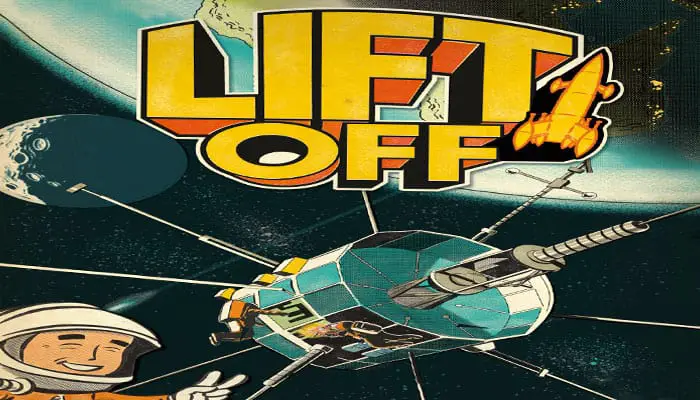
Components

- 1 Game Board
- 36 Specialist Cards,
- 8 Lab Cards, 96 Mission Cards
- 74 Technology Cards
- 16 Objective Cards,
- 50 Money Tokens
- 32 Upgrade Tokens,
- 11 Space Station Tokens
- 8 Score Tokens
- 1 Phase 2 Marker
- 4 Cardboard Player Boards
- 4 Cardboard Rockets
- 45 Wooden Rockets
- 1 Mission Sheet,
- Rulebook
Setup
-
Place the game board in the middle of the table, within reach of all players.
-

When playing with three players, return all specialist and mission cards with the number "4" in the bottom-left corner to the game box.
When playing with two players, return all specialist and mission cards with the numbers "3" or "4" in the bottom left corner to the game box.

Specialist Cards: Shuffle the remaining specialist cards and place them facedown next to the board, leaving room for a discard pile.
Mission Cards: Separate the mission cards by level, 1 through 4, and shuffle each deck separately. Place the level 1 and 2 decks on the corresponding spaces on the game board.
The level 3 and 4 decks are not available at the start of the game. Set aside these decks and the phase 2 overlay.
-

Space Station and Player Colors: Place the space station tokens next to the game board. Each player chooses a player color and takes the wooden rockets in that color.
When playing with three players, place two rockets of the unused color on the space station track: one rocket on a "6" space and one rocket on the "8" space.
When playing with two players, place three rockets: one rocket on each of the "6" spaces and one rocket on the "8" space.

Two-Player Setup
-
Technology Cards: There are four different colors of technology cards: Fuel (red), Energy (yellow), Life Support (blue), Food (green).

These colors do not correspond to the player colors in any way! Separate the Technology cards by color and place them next to the game board with the "1" side up.
-
Money: Choose one player to be the banker, and place the money tokens next to the game board near that player. Players can make change at an time, and money is not limited by the tokens in the supply.

-
Starting Player and 100/200 Score Markers: The player who has most recently been in space (or the youngest player) takes the first player rocket and will be the starting player for the first round.
The starting player places one of their wooden rockets on space 2 of the scoring track. In clockwise order, each player places one of their rockets two spaces higher than the previous player on the scoring track (for example, on spaces 2, 4, 6, and 8 in a four-player game).
Place the 100/200 score tokens next to the 0/100 space of the scoring track.
-
Objective Cards: Shuffle the objective cards and deal three cards facedown to each player. Players draft these cards during the final step of setup.
Return all remaining objective cards to the game box without looking at them.
-
Player setup: Each player takes a player board, a lab with the level
 side faceup, and the two-part rocket in their player color.
side faceup, and the two-part rocket in their player color.Place the level
 /
/  labs next to the game board. Return the unused player boards, rockets, and level
labs next to the game board. Return the unused player boards, rockets, and level  /
/  labs to the game box.
labs to the game box.
-
Rocket Upgrades: Place the capacity and propulsion upgrade tokens in each player's color next to the game board with the icons faceup.

Return the upgrades for any unused player colors to the game box.
Example Setup:
Player Setup
-
Place your player board faceup in front of you, leaving space for cards and tokens on both sides of the player board.
-

Place your lab, with the
 side faceup, in the notch on the left side of your player board. During the game, you can upgrade your lab, eventually replacing it with the level
side faceup, in the notch on the left side of your player board. During the game, you can upgrade your lab, eventually replacing it with the level  /
/  card.
card. -
Each of the four colored notches on the right side of your player board holds a different color of technology card, which you will gain over the course of the game.
-
Place your two-part rocket to the left of your lab, with the icons faceup.
-
The red bar on the left is the cost track, which indicates the current cost, in money, to launch a rocket. Place one of your rockets on the 5" space of the cost track.
The black bar on the right is the weight track, which indicates how much your rocket can carry. Place one of your rockets on the "1" space of the weight track.

The green bar on the bottom indicates your current income: the money you receive each round. Place one of your rockets on the "5" space of the income track.

Gaining and spending money: Effects that require you to spend money (such as launching a rocket) have a red icon. Effects that cause you to gain money have a green icon (such as the income track).
-
Leave room next to your rocket for your mission cards. During the game, mission cards will either be on Earth, waiting to be launched, or in space, after being launched.
Place missions that are on Earth next to the base of your rocket, and missions that are in space next to the top of your rocket. Keep these areas separated.
Final Setup
Before the beginning of the first round, players draft objective cards, take their starting money, and draw starting specialist cards.

First, players draft the three objective cards they were dealt during step 7 of setup. Each player chooses one card to keep and passes the remaining two cards to the player on their left.
Then, each player chooses two cards from the three they are currently holding and passes the remaining one card to the player on their left.
You can choose to pass a card that you previously kept. The three objective cards you have after drafting will be your objectives for this game.
Next, the banker gives each player ten money. Finally, each player draws three specialist cards, facedown.
Object of the Game
In Lift Off, your goal is to establish the most prestigious space agency by accumulating the most victory points ( ). The player with the most points at the end of the game wins.
). The player with the most points at the end of the game wins.
Game Play
Specialists allow you to improve your technologies, upgrade your rockets and lab, invest in the space station, and load and launch your rockets more efficiently.
You use your rockets to launch missions into space, securing valuable victory points for your agency. Whenever you score victory points, move your rocket up that many spaces on the score track. If a player's score exceeds 100 or 200, use the score markers to indicate this.
Lift Off is played in two phases, with four rounds in each phase. The game begins in phase 1 and continues in phase 2 after the fourth round. After the eighth round, the game ends, and players resolve final scoring.
Each round contains the following steps:
- Take income and draw new specialist cards.
- Draft specialist cards, then play two specialists.
- Draw mission cards and place them on Earth.
- Launch rockets to send mission cards into space.
- Discard played specialist cards.
Income And Specialists
1. Take income and draw new specialist cards
At the beginning of each round, the banker gives each player money equal to the current value on their income track. Each player then draws two specialist cards.
Exception: Skip step 1 during the first round of the game.
2. Draft and play specialists

Now that each player has three specialist cards, players draft specialists. The starting player chooses which direction specialists will be passed this round (left or right).
First, each player chooses one specialist card in their hand to keep, and passes the remaining two cards to the next player in the direction of the draft.
Then, each player chooses two specialist cards in their hand to keep, and passes the remaining card to the next player in the direction of the draft. You can always choose to pass a card that you previously kept during the draft.
After the draft is concluded and each player has three specialist cards in hand, players play their specialists. Beginning with the starting player and proceeding in the same direction as the specialist draft, each player plays and resolves one specialist card from their hand.
After each player has played one specialist card, each player plays and resolves a second specialist card, proceeding around the table in the same order. After playing specialists, you will have one specialist card left in your hand to carry over to the next round.
Each specialist has either a blue or a yellow
or a yellow  banner in the top right corner of the card, and either one or two actions associated with it. When you play a specialist card, you automatically gain the effect shown on the banner, and you can choose to either perform the actions on the card, or gain money instead.
banner in the top right corner of the card, and either one or two actions associated with it. When you play a specialist card, you automatically gain the effect shown on the banner, and you can choose to either perform the actions on the card, or gain money instead.

The effects from blue banners are resolved immediately as soon as you play that specialist, giving you either three money  or five points
or five points  as shown on the banner. The effects from yellow banners are resolved later in the round, while launching missions.
as shown on the banner. The effects from yellow banners are resolved later in the round, while launching missions.

When you play a specialist card, you can choose to perform one or both of the actions shown on the card. Specialists with two actions have a dividing line indicating the separate actions.
If the specialist has two actions on the card, you can perform the actions in any order, but must complete one action before performing the next
action. Alternatively, you can choose not to perform any of the actions on the card and gain two money  instead (strategically, this can be a good idea).
instead (strategically, this can be a good idea).
Missions
3. Draw mission cards and place them on earth
First, in clockwise order beginning with the starting player, choose one of the available mission decks on the game board. During phase 1, only decks  and
and  are available. Decks
are available. Decks  and
and  become available during phase 2.
become available during phase 2.
 Mission Decks |

Draw three mission cards from the chosen deck. Choose one of these three cards and place it faceup on Earth next to your rocket.
Place the other two cards in the corresponding mission discard pile. If a mission deck is empty, shuffle the discard pile to form a new facedown mission deck.
You can have only one copy total of each mission, both on Earth and in space. If you already have a copy of a mission, either on Earth or in space, you cannot take another copy of that mission (except as noted on individual cards).
If you cannot take any of the mission cards you drew, you must continue drawing mission cards from the same deck, one at a time, until you draw one that you do not already have. Take that mission card, discarding all other drawn mission cards.
You cannot have more than seven mission cards total from each deck. If you already have seven mission cards from a deck, you cannot draw mission cards from that deck.
4. Launch Rockets To Send Mission Cards Into Space
You launch rockets to send mission cards from Earth into space, moving them from the Earth area to the space area next to your rocket.
Beginning with the starting player and proceeding clockwise, each player can send up to three missions into space by launching rockets. You can launch multiple rockets during this step.
The following is required to launch a rocket:
-

You must have a launch symbol from your lab or played specialists.
Your lab has one launch symbol, and some specialists give you additional launch symbols when played, which you can use to launch additional rockets during that turn. Each launch symbol you have allows you to launch one rocket.
-

You must pay for the launch. The cost track on your player board shows the cost in money to launch rocket. Some specialists reduce the cost of launching a rocket.
-
Your rocket must have sufficient capacity to send up the missions. The weight track on your player board shows the capacity of your rocket. Your rocket can send up any number of missions with a combined weight less than or equal to the capacity of the rocket.
For example, if your rocket has three capacity, it can send up one mission with a weight of three or less, or multiple missions whose weights add up to three or less. Some specialists can increase the capacity of your rocket for a single launch.
-
The level of your lab must be equal to or higher than the level of the mission(s) you are sending up.

-
You must meet the minimum technology requirements for the mission level. The requirements for each level are printed on the game board above the corresponding mission decks.
A slash between requirements means that you need to meet only one of the indicated requirements. Technology cards are not expended when you launch rockets; they track your level of advancement in that technology.

-
You must have at least one mission on Earth that you can launch, based on the requirements above. You must launch at least one mission with each rocket launch.

If you meet all of these conditions, you can launch a rocket. You immediately score victory points for each launch, regardless of the number of missions you sent up, based on the level of your lab and the current phase, as shown on the lab card.
Move each mission card you sent up from Earth to space. Missions in space score you victory points and can have additional effects.
Mission Card Structure and Effects
Some mission cards show victory points on the left side of the card. When you send one of these missions to space, you score that many victory points.

Most missions have an effect depicted in the lower half of the card. If the mission has an hourglass symbol, the mission's effect resolves during final scoring.
Otherwise, the effect resolves immediately, when the mission is sent to space. If you send multiple missions into space with a single launch, you choose the order in which their effects resolve.
Note: If everyone is familiar with the game, players can launch rockets simultaneously.
End of the Round
After all players have launched rockets, the round ends. Discard the specialists you played this round, keeping the specialist still in your hand for the next round.
The starting player gives the starting player rocket to the player to their left. Begin the new round by taking income and drawing specialist cards.
At the end of the fourth round (the first time the specialist deck is empty at the end of the round) proceed to phase 2.
At the end of the eighth round (the second time the specialist deck is empty at the end of the round) the game ends and players resolve final scoring.
Phase 2 Setup
At the end of the fourth round, the first time the specialist deck is empty at the end of the round, phase 1 ends and phase 2 begins.
-
Place the level
 and
and  mission decks in the corresponding spaces on the game board. Level
mission decks in the corresponding spaces on the game board. Level  and
and  missions are now available.
missions are now available. -
Place the phase 2 overlay on the corresponding space on the game board, covering the previous requirements. Level
 missions now require a higher level of technology.
missions now require a higher level of technology.
-
Beginning with the starting player, each player can discard any number of their objective cards. For each objective card you discard, you gain five money. Return discarded objective cards to the game box.

Once each player has had the opportunity to discard objective cards, the game continues with phase 2.
At the end of the eighth round, the second time the specialist deck is empty at the end of the round, the game ends, and players resolve final scoring.
Specialist Card Effects
Each specialist has a banner and either one or two actions. You always gain the effect of the banner, and can choose to use one or both of the actions.
Banner Effects:

Immediately gain three money.

Immediately score five points.
When launching rockets:

You can use this effectto increase the capacity of one rocket for one launch by the indicated amount. The additional capacity applies only to a single rocket launch.
If you have two specialists with this effect, you can combine the effects on a single launch.
When drawing mission cards:

You can draw one additional mission card of the chosen level, and place one additional card on Earth. If you have two specialists with this effect, you can draw and keep up to two additional cards.
When launching rockets:

You have one additional launch symbol. When using this launch symbol to launch a rocket, the launch costs two less money than normal.
Actions
Each specialist has either one or two actions. When you perform a specialist's actions, you can perform one or both actions, in any order.
You can always choose not to perform any of a specialist's actions, and instead take two money. You always gain the banner effect, regardless of whether or not you perform the actions.
Building the Space Station
Each time you invest in the space station, you can add a new piece to the growing station, building a hub of research and discovery for the benefit of humanity high above the Earth.
The space station can be built in a myriad of configurations, but how the station is built does not impact gameplay.
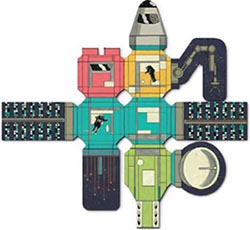
Labs
The higher the level of your lab, the more points you will score for each rocket launch. Rocket launches during phase 1 are worth more points than launches during phase 2, with labs of equal level. The level  lab has an additional benefit: The launch using the launch symbol from your lab has one additional capacity.
lab has an additional benefit: The launch using the launch symbol from your lab has one additional capacity.
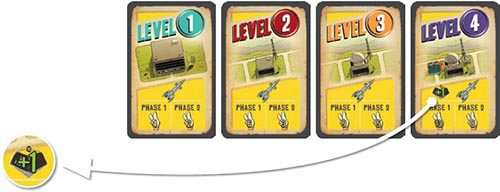
Objective Cards
You score points from objective cards during final scoring by fulfilling the conditions shown on the cards. The top of each objective card shows what the objective card will score points for. The column on the right shows how many points you will score, based on the quantities on the left.
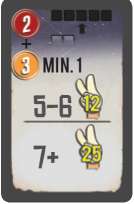
These cards score you points based on the number of missions of specific level(s) you have in space.
This card counts your level 2 and 3 mission cards in space. You must have at least one level 3 mission card in space to score points from it.
If you have five or six level 2 and 3 missions, at least one of which is level 3, you score 12 points from this card. If you have seven or more such missions, you score 25 points.
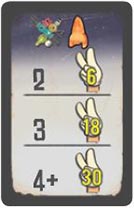
This card scores you points based on how many times you invested in the space station. To track this, count your rockets on or next to the space station track.
If you have two rockets on or next to the space station, you score six points. If you have three, you score 18 points. If you have four or more, you score 30 points.
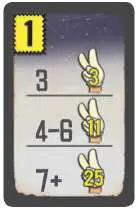
These cards score you points based on the number of technology cards of a specific color you have.

This card counts your yellow technology cards. If you have three yellow technology cards, you score three points.
If you have four to six, you score 11 points. If you have seven or more, you score 25 points.

This card scores you points based on how many capacity and propulsion upgrades (total) you have.
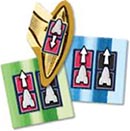
If you have four total upgrades, you score five points. If you have five or six, you score 15 points. If you have seven or more, you score 20 points.
End of the Game
Each player totals up their points as follows:

Score points for each of your missions in space with an hourglass symbol, based on their individual conditions.
Score points for each of your objective cards.
Score three points for each of your green technology cards, and one point for every five money you have.
The player with the most victory points after final scoring wins the game!
In the event of a tie, the player with the most level 4 missions in space wins the game. If there is still a tie, the tied players share the victory.
Continue Reading
